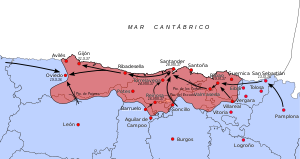| Revision as of 06:12, 19 December 2013 editChrisGualtieri (talk | contribs)Autopatrolled, Pending changes reviewers, Rollbackers457,369 editsm Remove stub template(s). Page is start class or higher. Also check for and do General Fixes + Checkwiki fixes using AWB← Previous edit | Revision as of 13:56, 4 July 2014 edit undoGene93k (talk | contribs)Autopatrolled, Extended confirmed users, New page reviewers, Pending changes reviewers468,094 edits disambiguated: "Gabriel Jackson" → "Gabriel Jackson (hispanist)"Next edit → | ||
| Line 22: | Line 22: | ||
| ==Background== | ==Background== | ||
| Bilbao was the capital of the ] established by the Republic after the war began. This establishment was in payment for ] support of the Republic. The Basque people in Spain generally inhabit four provinces, ], ], ] and ]. The Basque Nationalists were dominant in the latter two provinces. Navarre and Álava had rallied to the rising against the Republic.<ref>{{cite book |authorlink=Gabriel Jackson |first=Gabriel |last=Jackson |title=The Spanish Republic and the Civil War, 1931–1939 |year=1965 |location= |publisher= |page=384 }}</ref> | Bilbao was the capital of the ] established by the Republic after the war began. This establishment was in payment for ] support of the Republic. The Basque people in Spain generally inhabit four provinces, ], ], ] and ]. The Basque Nationalists were dominant in the latter two provinces. Navarre and Álava had rallied to the rising against the Republic.<ref>{{cite book |authorlink=Gabriel Jackson (hispanist) |first=Gabriel |last=Jackson |title=The Spanish Republic and the Civil War, 1931–1939 |year=1965 |location= |publisher= |page=384 }}</ref> | ||
| The Spanish Nationalists troops gained ] early in the war with the fall of ] in August and ], September 13, 1936,<ref>{{cite book |authorlink=Hugh Thomas (writer) |first=Hugh |last=Thomas |title=The Spanish Civil War |year=2001 |edition=Rev. ed. |location=New York |publisher=Modern Library |page=397 |isbn=0375755152 }}</ref> isolating the Basque country and the Northern Republican held zone from the French frontier. On 31 March, the Nationalist, led by the General Mola, launched an offensive against the ] province. The Basque troops had to retire and by June the Nationalist reached the outskirts of Bilbao. | The Spanish Nationalists troops gained ] early in the war with the fall of ] in August and ], September 13, 1936,<ref>{{cite book |authorlink=Hugh Thomas (writer) |first=Hugh |last=Thomas |title=The Spanish Civil War |year=2001 |edition=Rev. ed. |location=New York |publisher=Modern Library |page=397 |isbn=0375755152 }}</ref> isolating the Basque country and the Northern Republican held zone from the French frontier. On 31 March, the Nationalist, led by the General Mola, launched an offensive against the ] province. The Basque troops had to retire and by June the Nationalist reached the outskirts of Bilbao. | ||
Revision as of 13:56, 4 July 2014
| Battle of Bilbao | |||||||||
|---|---|---|---|---|---|---|---|---|---|
| Part of the Spanish Civil War | |||||||||
 The Northern Front. Bilbao is on the right of the red area. | |||||||||
| |||||||||
| Belligerents | |||||||||
|
|
| ||||||||
| Strength | |||||||||
| 50,000 troops and militia |
60,000 Nationalist troops 15,000 Italian troops | ||||||||
| Casualties and losses | |||||||||
| Unknown |
Nationalist Spain: Unknown Italy: 105 dead 427 wounded three missing | ||||||||
The Battle of Bilbao was part of the War in the North, during the Spanish Civil War where the Nationalist Army captured the city of Bilbao and the remaining parts of the Basque Country still held by the Republic.
Background
Bilbao was the capital of the autonomous Basque area established by the Republic after the war began. This establishment was in payment for Basque Nationalist support of the Republic. The Basque people in Spain generally inhabit four provinces, Navarre, Álava, Gipuzkoa and Biscay. The Basque Nationalists were dominant in the latter two provinces. Navarre and Álava had rallied to the rising against the Republic.
The Spanish Nationalists troops gained Gipuzkoa early in the war with the fall of Irún in August and San Sebastián, September 13, 1936, isolating the Basque country and the Northern Republican held zone from the French frontier. On 31 March, the Nationalist, led by the General Mola, launched an offensive against the Biscay province. The Basque troops had to retire and by June the Nationalist reached the outskirts of Bilbao.
The Battle
By June 11, 1937, the Basque forces had fallen back to the city of Bilbao, which was defended by a series of rushed fortifications called the "Bilbao's Iron Ring." The Iron Ring was poorly designed for defense. It was quite an antiquated defense concept akin to First World War fortifications, so it was vulnerable to modern warfare weapons of its time such as aircraft and artillery, and only 30,000 troops were defending it (it was conceived to be defended by 70,000)—therefore the Iron Ring was rather easily overcome by Nationalist forces.
The ring was breached by an infantry assault supported by heavy air and artillery bombardment (150 guns and 70 bombers). On 12 June, the Spanish Republican Army launched a diversionary attack against Huesca in order to stop the Nationalist offensive, but the Nationalist troops continued their advance. On the night of June 13 the defenders evacuated most of the civilian population from the city. On June 18, General Ulibarri withdrew his remaining troops from Bilbao and the Nationalists occupied the city on the following day. The city's bridges had been destroyed to hinder the attackers but the city remained mostly intact.
Notes
- Jackson, Gabriel (1965). The Spanish Republic and the Civil War, 1931–1939. p. 384.
- Thomas, Hugh (2001). The Spanish Civil War (Rev. ed. ed.). New York: Modern Library. p. 397. ISBN 0375755152.
{{cite book}}:|edition=has extra text (help) - Gabriel Jackson, pp. 380-384.
- Template:Eu icon Josu CHUECA: «Burdin Gerrikoa puskatuta», 36ko Gerra orain.
- Template:Es icon Imanol VILLA: «El Cinturón de Hierro», El Correo, 2007-02-11.
- Beevor, Antony (2006). The Battle for Spain. The Spanish Civil War, 1936–1939. London: Penguin Books. p. 236. ISBN 014303765X.
43°15′N 2°55′W / 43.250°N 2.917°W / 43.250; -2.917
Categories: